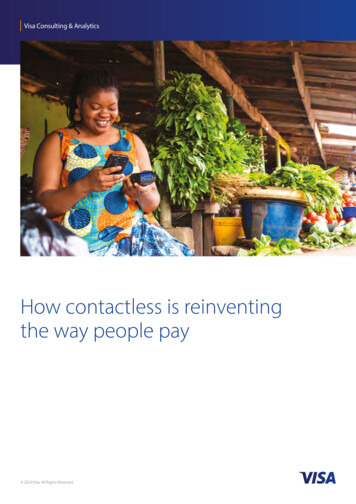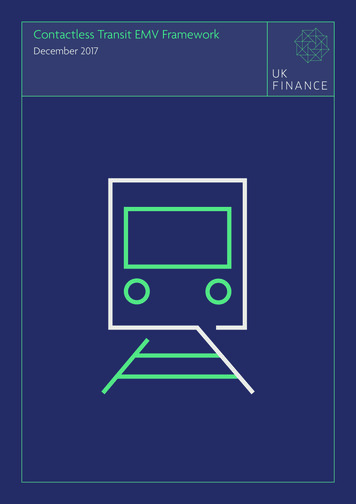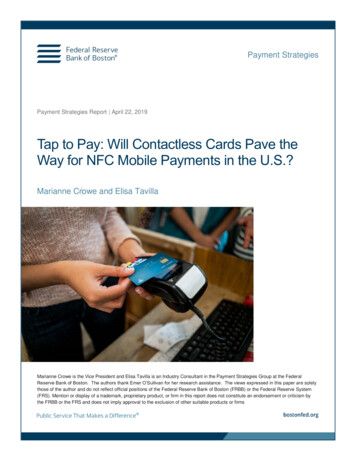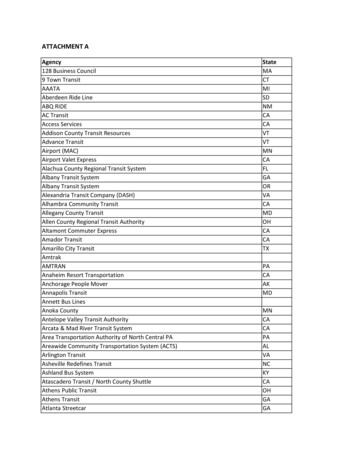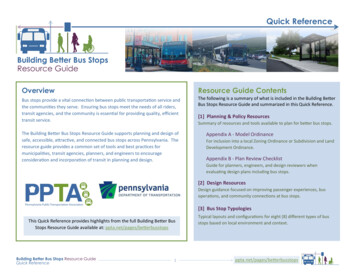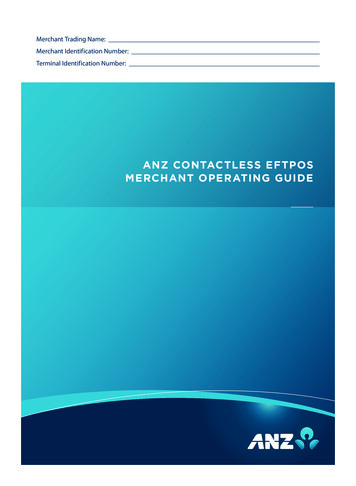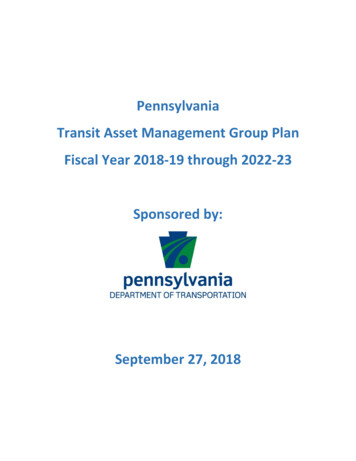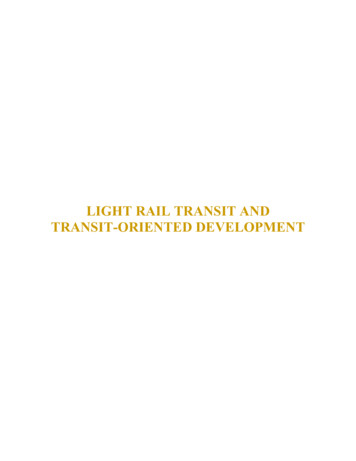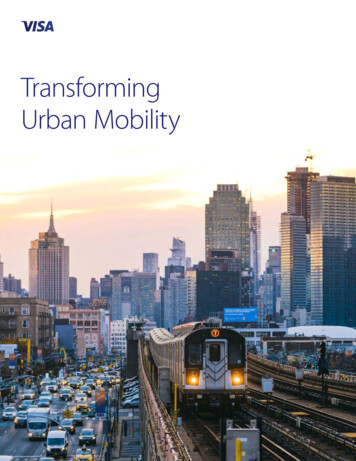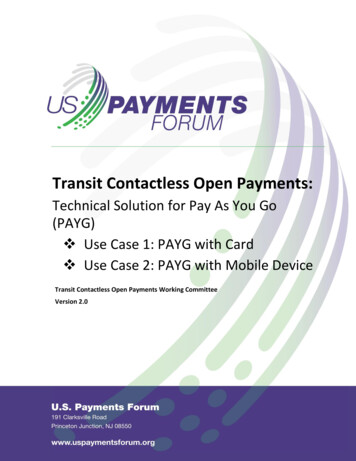
Transcription
Transit Contactless Open Payments:Technical Solution for Pay As You Go(PAYG) Use Case 1: PAYG with Card Use Case 2: PAYG with Mobile DeviceTransit Contactless Open Payments Working CommitteeVersion 2.0U.S. Payments Forum 2018Page 1
About the U.S. Payments ForumThe U.S. Payments Forum, formerly the EMV Migration Forum, is a cross-industry body focused onsupporting the introduction and implementation of EMV chip and other new and emerging technologiesthat protect the security of, and enhance opportunities for payment transactions within the UnitedStates. The Forum is the only non-profit organization whose membership includes the entire paymentsecosystem, ensuring that all stakeholders have the opportunity to coordinate, cooperate on, and have avoice in the future of the U.S. payments industry. Additional information can be found athttp://www.uspaymentsforum.org.About the Transit Contactless Open PaymentsWorking CommitteeThe goal of the Transit Contactless Open Payments Working Committee is for all interested stakeholdersto work collaboratively to identify possible technical solutions that address the challenges associatedwith the implementation of contactless open loop acceptance terminals at gated customer points ofentry within the unique retail environment of the U.S. and Canadian public transit market.EMV is a trademark owned by EMVCo LLC.Version HistoryVersion 2.0, September 2018 – Use Case 2: Pay As You Go/Mobile incorporatedVersion 1.0, September 2017 – Initial publication with Use Case 1: Pay As You Go/CardCopyright 2017, 2018 U.S. Payments Forum and Secure Technology Alliance. All rights reserved. TheU.S. Payments Forum has used best efforts to ensure, but cannot guarantee, that the informationdescribed in this document is accurate as of the publication date. The U.S. Payments Forum disclaims allwarranties as to the accuracy, completeness or adequacy of information in this document. Commentsor recommendations for edits or additions to this document should be submitted to: Transit-OpenPayments@uspaymentsforum.org.U.S. Payments Forum 2018Page 2
Table of Contents1.Introduction . 51.11.21.31.4U.S. Payments Forum Antitrust Compliance Statement . 5Key Terms. 5General Background. 9Purpose . 122.Background on the Transit Environment. 132.12.2Overview . 13Unique Aspects of the Transit Environment . 133.Description of Use Case 1: Pay As You Go / Card . 153.13.23.33.4Definition . 15Transit Merchant Use Case 1 Requirements . 15Acquirer/Processor Transit Use Case 1 Requirements . 16Issuer Transit Use Case 1 Requirements . 174.Technical Functional Proposal for Use Case 1 . 184.14.24.34.3.1Online and Offline Authentication . 184.3.2Types of Offline Authentication . 194.3.3Differences between Credit and Debit Card Authentication . 204.3.4Solution . 204.3.5Stakeholder Impact . 204.4Step 2: Cardholder Verification. 214.4.1Differences between Credit and Debit Cardholder Verification . 224.4.2Solution . 224.4.3Stakeholder Impact . 234.5Step 3: Financial Authorization . 234.5.1Differences between Credit and Debit Authorization . 244.5.2Solution . 254.5.3Stakeholder Impact . 254.65.Approach to Developing the Solution . 18Three Pillars to a Secure Transaction: Card Authentication, Cardholder Verification, FinancialAuthorization . 18Step 1: Card Authentication . 18Transaction Flow Diagram . 28Use Case 1 Conclusion . 30U.S. Payments Forum 2018Page 3
6.Description of Use Case 2: Pay As You Go / Mobile . 346.16.2Introduction . 34Description of Use Case 2: Pay As You Go / Mobile . 356.2.1Definition. 356.2.2Transit Merchant Use Case 2 Requirements. 356.2.3Acquirer/Processor Transit Use Case 2 Requirements . 356.2.4Issuer Transit Use Case 2 Requirements . 366.3Technical Functional Proposal for Use Case 2 . 366.3.1ODA and Mobile Device Security Technology (SE, HCE and TEE) . 366.3.2No CVM and CDCVM (Device Unlock/Wallet Access) . 376.3.3Tokenization . 386.3.4Payment Account Reference (PAR) . 406.3.5Deferred Authorization and Customer Messaging Impact . 416.47.Use Case 2 Conclusion . 41Legal Notice. 44U.S. Payments Forum 2018Page 4
1. Introduction1.1 U.S. Payments Forum Antitrust Compliance StatementThis paper was prepared in compliance with the U.S. Payments Forum Antitrust Compliance Statement,which is stated below:U.S. Payments Forum activities and meetings of U.S. Payments Forum members and participantsnecessarily involve cooperation of industry competitors. Accordingly, it is the express policy of theForum to require that all of its activities be conducted strictly in accordance with applicable antitrustlaws. It is therefore extremely important that members and meeting attendees adhere to meetingagendas, comply with the Forum bylaws and Secure Technology Alliance Antitrust Guidelines, and, at alltimes, be aware of and not participate in any activities that are prohibited under applicable U.S. state,federal or foreign antitrust laws.Examples of types of actions that are prohibited at Forum meetings and in connection with its activitiesare: price fixing, agreements to allocate customers or markets, boycotts and other “concerted refusalsto deal,” as well as discussion of or agreements regarding discriminatory pricing, discounts, incentives,awards, penalties, compliance and enforcement programs and other related matters. Any discussion ofsuch activity is strictly prohibited.Forum bylaws are available at: 012/08/US Payments Forum Bylaws-FINAL-June-2016.pdfSecure Technology Alliance Antitrust Guidelines are availableat: -2017.pdf1.2 Key TermsThese key terms are defined for purposes of their use in this paper, including those key terms which aredefined for use only within other key terms only. 1Access form factor (or a credential): A card associated in the merchant system with a storedfare product (dollar value or a pass) that has been purchased in advance, and which can be usedto gain entry through a Paid In Advance transaction. Such card could be credit, debit, orprepaid, including gift cards and electronic benefit transfer (EBT) cards.Active Wearable: A wearable that includes the same functionality described for passivewearables (see definition of passive wearable), plus another connectivity option – for example,Bluetooth or WiFi – and requires a battery. The secure element has a means to connect to therest of the world through an interface other than the ISO/IEC 14443 contactless interface.1Application Transaction Counter (ATC): A counter, maintained by the chip card application(incremented by the chip), that provides a sequential reference to each transaction. EachReferenced from Secure Technology Alliance white paper: Implementation Considerations for ContactlessPayment-Enabled Wearables, October 2017, -enabled-wearables/.U.S. Payments Forum 2018Page 5
23456payment application has its own ATC.2 A duplicate ATC, a decrease in ATC or a large jump in ATCvalues may indicate data copying or other fraud to the issuer.Card: For purposes of this paper, a form factor for a payment credential that is a chip-enabledplastic card issued by a financial institution which has an EMV contactless interface and withwhich a Pay As You Go transaction can be made. Such card could be a credit, debit, prepaid, giftor benefit transfer (e.g., transit, EBT) card.Certificate Authority (CA): A trusted third-party entity that manages and issues securitycertificates and public keys that are used for secure communication in a public network. The CAis part of the public key infrastructure (PKI) along with the registration authority (RA) whoverifies the information provided by a requester of a digital certificate. If the information isverified as correct, the certificate authority can then issue a certificate.3Consumer Device Cardholder Verification Method (CDCVM): A method that uses a consumer’smobile payment device (e.g., phone, wearable, card) to authenticate cardholder identity in amobile payment transaction (e.g., PIN or biometrics).4 Also known as On-Device CardholderVerification Method or ODCVM.Deferred Authorization: An authorization request or financial request that occurs when amerchant captures transaction information while connectivity is interrupted; the merchantholds the transaction until connectivity is restored. After connectivity is restored, the merchantsends the transaction to make an online authorization request, and receives an authorizationresponse from the issuer. A subset of “Delayed Authorization.” For the purpose of thisdocument, the term “deferred authorization” will be used to describe any tap-relatedtransaction authorization sent after the transit customer has been allowed entry to travel.Delayed Authorization: An authorization request sent any time after the transit customer hasbeen allowed entry to travel. Refer to definition of Deferred Authorization.Device PAN (DPAN): "DPAN" (Device Primary Account Number also known as the "Digital"Primary Account Number) is a mobile-device-specific identifier that is a tokenized version of theFPAN of the card provisioned to the payment-enabled device. The tokenization is based on theEMVCo Tokenization Framework.5 The DPAN is then used in place of the FPAN to securelyhandle payment transactions.Digital Wallet: A software representation of a physical wallet. For example, putting debit andcredit cards into an application that holds payment credentials through which someone can pay,using the digital version of the debit or credit cards in that person’s physical wallet, linking tothe same account, to pay.6Dual Message: Payment processing method where an authorization message is sent to performa status check or hold funds for a given time period, followed by a financial message and matchto the hold.Referenced from the “EMV Migration Forum: Communications & Education Working Committee Standardizationof Terminology,” Version 2.1, January 2014, erminology/.Referenced from techopedia.com: icate-authority-ca.Referenced from the U.S. Payments Forum Mobile and Contactless Payments Glossary, V1.0, September tactless-payments-glossary/.EMV Payment Tokenisation Specification – Technical Framework,” Version 2.0, Sept. 8, t-tokenisation/.Same as footnote 4.U.S. Payments Forum 2018Page 6
EMV Payment Token: A token used in lieu of a PAN which is based on the EMVCo TokenizationFramework standard.7Fixed fare: The cost of a ride is constant or flat.Funding PAN (FPAN): See the definition of PAN.Host Card Emulation (HCE): HCE is a mechanism for an application running on the “host”processor (the mobile device’s main processor–where most consumer applications run) toperform NFC card emulation transactions with an external reader. Examples of HCEimplementations include the Android operating system (Android KitKat 4.4 and higher) and theBlackBerry operating system.8Merchant Host: The backend (or back office) of the merchant’s payment acceptance system.Mobile Device: For purposes of this paper, a form factor for a payment credential that is an NFCpayment-enabled mobile device or active wearable and with which a Pay As You Go transactioncan be made. Such device will be payment-enable
U.S. Payments Forum 2018 Page 6 payment application has its own ATC.2 A duplicate ATC, a decrease in ATC or a large jump in ATC values may indicate data copying or other fraud to the issuer. Card: For purposes of this paper, a form factor for a payment credential that is a chip-enabled
